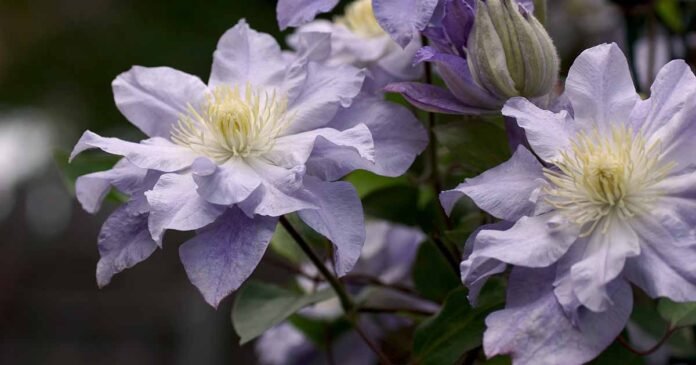Clematis is rightly known as the queen of the vines for its regal performance in the garden.
It happily scrambles up and over arbors, pergolas, and trellises, as well as through other plants, creating beautiful walls of rich color.
A carefree perennial, the striking, star-like flowers bloom in shades of blue, pink, purple, red, white, and yellow from late winter into spring, summer, and early autumn.

But not all varieties of this showy climber are cold hardy, and many can benefit from some preventative winter care.
With protection from freezing temperatures and hard frosts, your vines will return with an abundance of flowers year after year.
Here’s what’s to come in our clematis winter care guide:
Clematis Basics
As a perennial, clematis are vigorous vines that return yearly, growing from the same plant stock.
Hardy in USDA Zones 3 to 9, there are some species that are even suitable for growing in chilly Zone 2.


However, there are both hardy and tender varieties available, and not all will survive extended freezing temperatures.
For those living in colder regions, winter hardiness is an important characteristic to take into account when purchasing.
Clematis have three distinct blooming periods that correspond to their pruning groups, known as Groups 1, 2, and 3 (aka Groups A, B, and C).
Knowing what group your plants belong to is important before you start any winter pruning.
Group 1
Group 1 are the early bloomers that flower on old wood in winter and early spring, and they require no pruning.


Some species in this group can survive Zones 3 to 5, although many won’t flower as profusely in these areas – air and soil temperatures usually don’t warm up enough to coincide with their early bloom periods.
This group also includes evergreen varieties, which are the most susceptible to frost damage.
Find our favorite Group 1 cultivar selections here.
Group 2
Group 2 varieties bloom vigorously in spring, with a lighter second flush in summer. Flowers grow on old and new wood respectively.


These plants get only a light trim in early spring, then a harder pruning in summer to encourage a second set of flowers on new growth.
These plants can also underperform somewhat in cold zones, for the same reason as Group 1s – they need warm temperatures early in the year.
Typically, Group 2 varieties have two bloom periods, but in cold regions this is often reduced to just one set of flowers on old wood in early summer.
Find our favorite Group 2 cultivar selections here.
Group 3
Group 3 plants flower in late spring, summer, and into autumn, with flowers blooming entirely on new wood.
This group gets cut back hard in winter, so frost damage to stems is negligible – a bonus in cold zones.


Group 3 types also have the most suitable bloom period for colder regions, with flowers blooming in the warmth of early summer right up until first frost.
Here are a few tips if you have existing clematis plants and aren’t sure what group they belong to:
Group 1s often develop thick, woody base stems measuring two to six inches across. They don’t get pruned, which allows them to grow larger than those in the other two groups.


